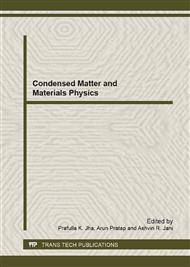p.8
p.15
p.22
p.29
p.37
p.43
p.49
p.53
p.58
Growth, Structural and High Pressure Study of GeS0.25Se0.75 and GeS0.75Se0.25 Single Crystals
Abstract:
The orthorhombic semi-conducting compound GeS0.25Se0.75 and GeS0.75Se0.25 possess interesting electrical properties and can been the subject of numerous investigations. The changes in solids under high pressure can reveal several new features of interatomic forces, which are responsible for their diverse physical properties. Authors have carried out growth of GeS0.25Se0.75 and GeS0.75Se0.25 crystals by Direct Vapor Transport (DVT) technique. For compositional confirmation energy dispersive analysis of X-ray (EDAX) has been used. EDAX results show that the grown crystals are nearly stoichiometrycally perfect. The grown crystals have been characterized by X-ray diffraction technique (using Philips X Pert MPD diffractometer) for structural characterization. These crystals are crystallized in orthorhombic structure. The values of lattice parameters, unit cell volume and X-ray density are calculated and presented. It is observed from lattice parameters, unit cell volume and X-ray density, that as the content of sulfur increases the value of all the lattice parameters decreases. High pressure study is also of great importance to visualize the mechanism governing the structural changes and to reveal solid state properties associated with different structure. For the room temperature measurement of resistance as a function of pressure, up to 7 GPa, the sample was set at the centre of the talc disc on the lower anvil. The pressure was generated by a hydraulic press on the Bridgman type tungsten carbide opposed anvil apparatus with in-situ Bismuth pressure calibration. The resistance was measured in several independent runs on these crystals as a function of pressure and was found to be reproducible. The results of variation of electrical resistance do not show presence of any phase transition up to 7 GPa. We investigate in GeS0.25Se0.75 and GeS0.75Se0.25 single crystals that as sulfur content increases, resistance of this compound increases.
Info:
Periodical:
Pages:
37-42
Citation:
Online since:
February 2013
Price:
Сopyright:
© 2013 Trans Tech Publications Ltd. All Rights Reserved
Share:
Citation:


